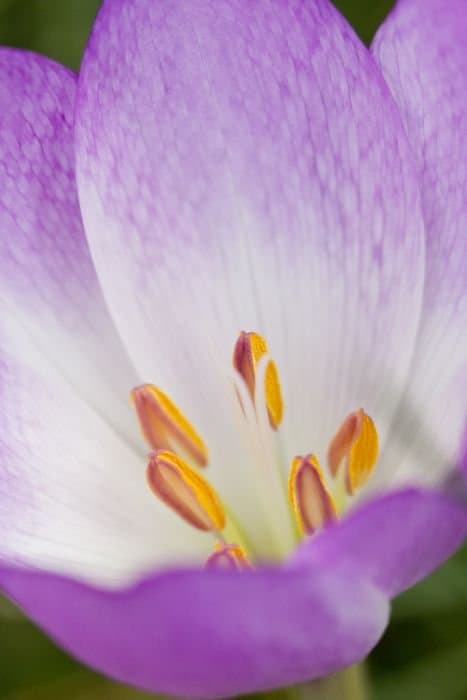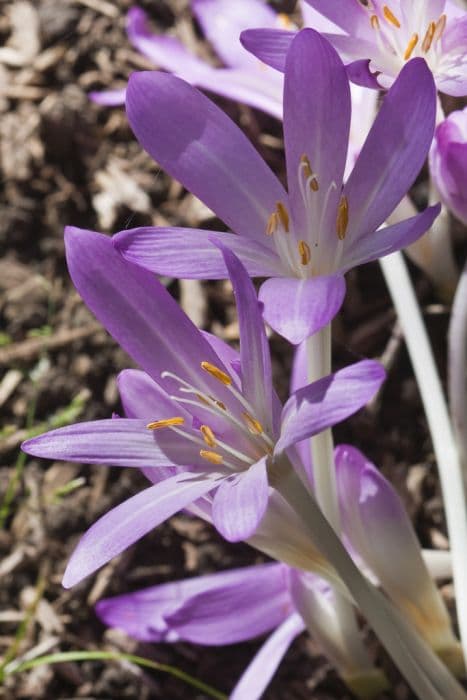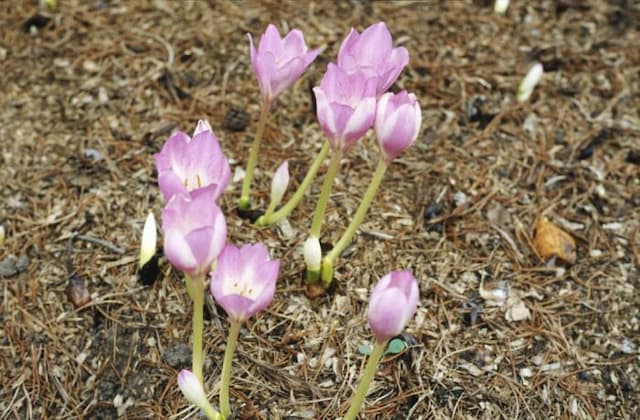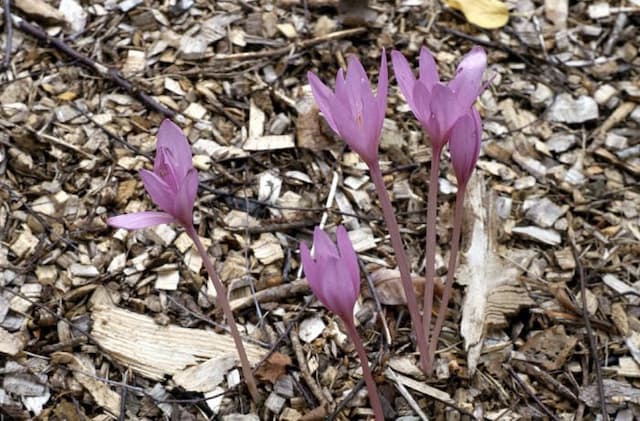Autumn Crocus Colchicum 'The Giant'

ABOUT
Colchicum 'The Giant' is a showy flowering plant with a remarkable appearance. It produces large, star-shaped blooms that create a striking display. The flowers come in a vibrant pink color, with delicate white throats that add contrast and appeal. Each petal is elongated and gently curves outward, contributing to the plant's lush and full-bodied look. The plant also has a lush clump of leaves that are glossy and rich green in color, providing a verdant backdrop for the vibrant flowers. These leaves generally emerge after the flowering period, adding greenery to the garden. The plant typically blooms in the fall, bringing color to the garden when many other plants are beginning to fade. The striking appearance of Colchicum 'The Giant' makes it a popular choice for gardeners looking to add a bold splash of color to their autumn landscape.
About this plant
 Names
NamesFamily
Colchicaceae
Synonyms
Giant Meadow Saffron, Giant Autumn Crocus
Common names
Colchicum 'The Giant'.
 Toxicity
ToxicityTo humans
Autumn Crocus (Colchicum 'The Giant') contains colchicine, a potent chemical that can be toxic to humans when ingested. Even small amounts of the plant can cause serious health issues. Symptoms of poisoning may include gastrointestinal distress such as nausea, vomiting, abdominal pain, and diarrhea, which can be bloody. Advanced poisoning can lead to multiple organ failure, including the kidneys and liver, respiratory distress, seizures, and it may be fatal. Medical attention should be sought immediately if ingestion is suspected.
To pets
Autumn Crocus is also toxic to pets such as dogs and cats. The colchicine it contains can lead to severe symptoms if ingested by pets. Signs of poisoning in pets might include drooling, vomiting, gastrointestinal bleeding, diarrhea, lethargy, abdominal pain, kidney damage, liver damage, and respiratory failure. Ingesting this plant is potentially life-threatening for pets, and urgent veterinary care is recommended if poisoning is suspected.
 Characteristics
CharacteristicsLife cycle
Perennials
Foliage type
Deciduous
Color of leaves
Green
Flower color
Pink
Height
1 feet 3 inches (38 cm)
Spread
1 feet (30 cm)
Plant type
Bulb
Hardiness zones
4
Native area
Mediterranean
Benefits
 General Benefits
General Benefits- Ornamental Appeal: Colchicum 'The Giant' has large, showy flowers that add aesthetic value to gardens.
- Late Blooming Cycle: It blooms in the fall, providing color to gardens when most other plants have finished flowering.
- Easy to Grow: This plant is low-maintenance, which makes it ideal for both novice and experienced gardeners.
- Naturalizing: It has the ability to spread and naturalize an area over time, creating larger displays each year.
- Drought Tolerance: Once established, Colchicum 'The Giant' is fairly drought-resistant, requiring minimal watering.
- Deer and Rodent Resistant: Its toxic nature deters deer and rodents from eating it, protecting it and nearby plants.
- Perennial Growth: As a perennial, it will return each year without the need for replanting.
 Medical Properties
Medical Properties- Colchicine Content: Colchicum 'The Giant', like other species in the Colchicum genus, contains colchicine, a compound used pharmacologically to treat gout and Familial Mediterranean Fever.
- Anti-inflammatory Properties: Due to the presence of colchicine, Colchicum 'The Giant' may offer anti-inflammatory benefits, as colchicine is known to reduce inflammation. However, the plant itself is not directly used for medicinal purposes.
- Antimitotic Agent: Colchicine within the plant has antimitotic properties, which means it can inhibit cell division, a principle used in treatment of diseases like gout where cell turnover needs to be controlled.
 Air-purifying Qualities
Air-purifying QualitiesThis plant is not specifically known for air purifying qualities.
 Other Uses
Other Uses- Colchicum 'The Giant' bulbs can be used as a deer and rodent deterrent, as the bulbs contain compounds that are unpalatable to many garden pests.
- The plant can be planted in mass displays or as an underplanting for deciduous trees, taking advantage of the autumn flowering when most plants are in decline.
- The foliage of the Colchicum 'The Giant' after flowering can be used to add a lush green texture to garden beds in spring before it dies back.
- The petals of Colchicum 'The Giant' can be used for natural dyeing processes, though this is not common.
- These plants can be used in educational settings to discuss bulb plant life cycles and adaptations, given their unusual autumn flowering period.
- The plant can serve as a food source for certain species of bees and other pollinators when few other plants are blooming in the autumn.
- Colchicum 'The Giant' can be used as part of a garden design to teach about and demonstrate sustainable gardening practices and the importance of seasonal blooms.
- It can function as a natural soil aeration tool since its deep-growing bulbs and roots may help to loosen the soil in a garden.
- Their rapid autumnal growth and swift dying back in spring can be utilized to illustrate topics in botany and plant biology educational programs.
- Gardeners may use Colchicum 'The Giant' to create a time-lapse video of their growth and bloom to capture the rapid lifecycle of the plant.
Interesting Facts
 Feng Shui
Feng ShuiThe Autumn Crocus is not used in Feng Shui practice.
 Zodiac Sign Compitability
Zodiac Sign CompitabilityThe Autumn Crocus is not used in astrology practice.
 Plant Symbolism
Plant Symbolism- Renewal and Hope: Colchicum 'The Giant', commonly known as autumn crocus, often blooms in the fall, signifying the transition from the end of one life cycle to the beginning of another and representing the eternal hope that comes with change.
- Resilience: Despite flowering at a time when most other plants are winding down for the year, the autumn crocus demonstrates resilience by pushing through the cooling earth to blossom.
- Beauty and Vanity: With its large, showy flowers, the autumn crocus is sometimes associated with beauty and, by extension, with the vanity and fleeting nature of aesthetic attractions.
- Caution and Danger: The autumn crocus is toxic and has been historically used medicinally in small doses, symbolizing the duality of medicine and poison and reminding us of the dangers that can lurk beneath beauty and necessitate caution.
 Water
WaterAutumn Crocus should be watered moderately during the growing season, but it is crucial not to over-water as the bulbs can rot. During the spring and summer, when the plant is dormant, keep the soil almost completely dry. In the fall, when the leaves and flowers emerge, increase watering to once a week, providing about half a gallon for outdoor plants to ensure the soil is evenly moist but not saturated.
 Light
LightAutumn Crocus thrives best in partial shade to full sunlight. The ideal spot for this plant would be in an area that receives morning sunlight and is protected from the harsh afternoon sun. A location under deciduous trees that allows sunlight through in the fall but provides shade in the summer is optimal for this bulbous plant.
 Temperature
TemperatureAutumn Crocus prefers temperate climates and can withstand winter chill. The plant is hardy and can survive in temperatures as low as 30 degrees Fahrenheit but should not be exposed to prolonged periods below freezing. The ideal temperature range for most active growth is between 50 to 70 degrees Fahrenheit.
 Pruning
PruningAutumn Crocus does not require regular pruning, but spent flowers should be removed after blooming to maintain a tidy appearance. The foliage should be left to die back naturally, as it nourishes the bulbs for the next growing season. Pruning, in this case, simply involves the removal of dead or yellowing leaves in late spring or early summer.
 Cleaning
CleaningNot needed
 Soil
SoilAutumn Crocus 'The Giant' thrives best in well-drained soil with a neutral to slightly alkaline pH, between 6.5 and 7.5. A soil mix composed of equal parts loam, sand, and leaf mold or compost is ideal to ensure adequate drainage and fertility.
 Repotting
RepottingAutumn Crocus 'The Giant' does not require frequent repotting; it's best to repot it every 3-4 years or when the corms become overcrowded.
 Humidity & Misting
Humidity & MistingAutumn Crocus 'The Giant' prefers moderate humidity levels but is tolerant of the wide range typically found in temperate climates.
 Suitable locations
Suitable locationsIndoor
Place in bright, indirect light with cool temperatures.
Outdoor
Plant in dappled shade or full sun; protect from harsh weather.
Hardiness zone
4-10 USDA
 Life cycle
Life cycleColchicum 'The Giant', commonly known as autumn crocus, begins its growth cycle in late summer or early fall when it emerges from dormancy and produces large, purple-pink flowers. After flowering, the plant enters a period of photosynthesis through its foliage, which persists through the winter and early spring, gathering energy for the next cycle. Once the leaves die back in late spring, the plant enters a dormancy phase during the hot summer months, conserving its energy underground in the form of a corm. In the dormant period, the corm undergoes development, preparing for the next flowering season. As temperatures cool again, the cycle repeats itself with the autumn crocus producing new flowers, often without any foliage present, to start the cycle anew. The plant can propagate either by seed after the flowers are pollinated or vegetatively through the division of its corms, giving rise to new plants that will follow the same life cycle.
 Propogation
PropogationPropogation time
Spring-Early Summer
Propogation: Colchicum 'The Giant', commonly known as giant meadow saffron or giant autumn crocus, is typically propagated by division of its corms. The best time for dividing the corms is in summer when the plant is dormant, after the foliage has died back and before the new growth begins in the fall. To propagate, carefully lift the corms from the ground and gently brush off the soil. You may notice smaller cormlets attached to the main corm, which can be separated and planted individually. Ensure each cormlet has a section of the basal plate to guarantee it can develop into a new plant. The corms and cormlets should then be planted around 3 to 4 inches (7.5 to 10 centimeters) deep and spaced about 6 inches (15 centimeters) apart in well-drained soil. This clonal propagation mirrors the natural reproduction of the plant and maintains the genetic characteristics of the parent plant.









